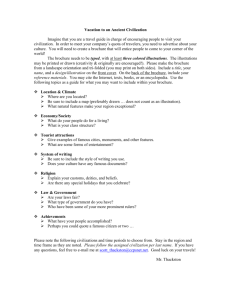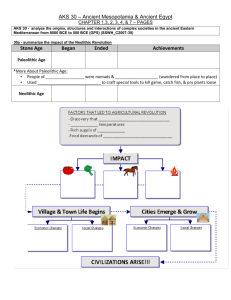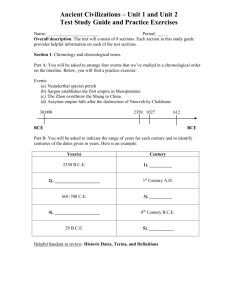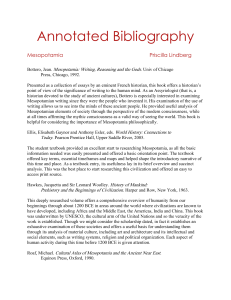Ancient Near East
advertisement
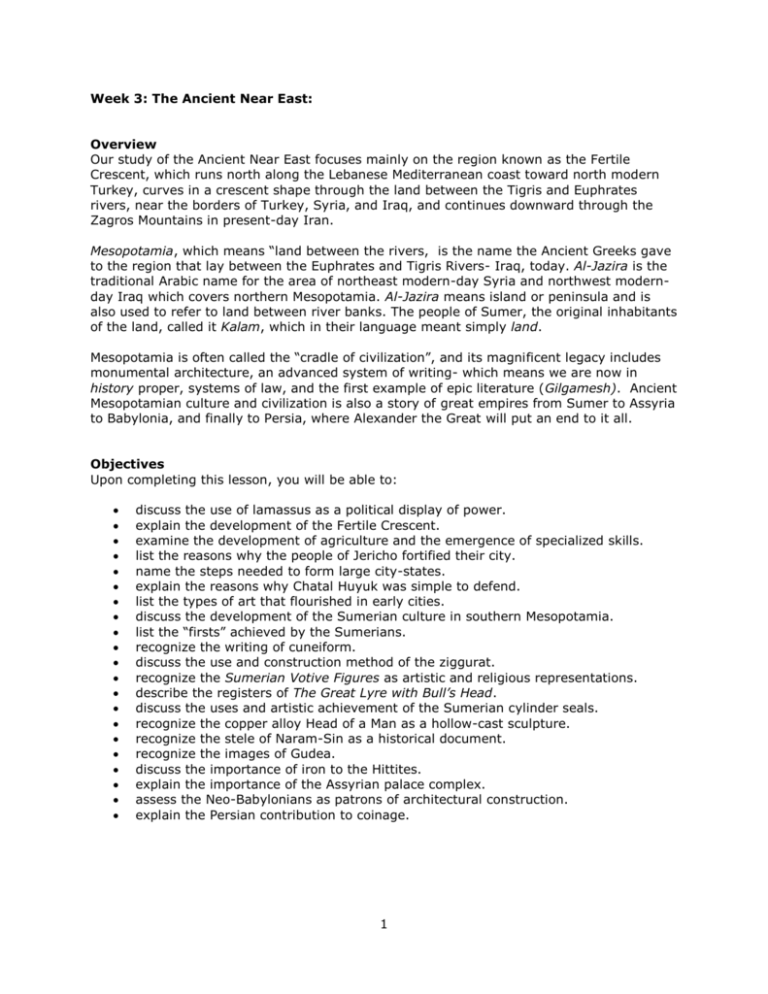
Week 3: The Ancient Near East: Overview Our study of the Ancient Near East focuses mainly on the region known as the Fertile Crescent, which runs north along the Lebanese Mediterranean coast toward north modern Turkey, curves in a crescent shape through the land between the Tigris and Euphrates rivers, near the borders of Turkey, Syria, and Iraq, and continues downward through the Zagros Mountains in present-day Iran. Mesopotamia, which means “land between the rivers, is the name the Ancient Greeks gave to the region that lay between the Euphrates and Tigris Rivers- Iraq, today. Al-Jazira is the traditional Arabic name for the area of northeast modern-day Syria and northwest modernday Iraq which covers northern Mesopotamia. Al-Jazira means island or peninsula and is also used to refer to land between river banks. The people of Sumer, the original inhabitants of the land, called it Kalam, which in their language meant simply land. Mesopotamia is often called the “cradle of civilization”, and its magnificent legacy includes monumental architecture, an advanced system of writing- which means we are now in history proper, systems of law, and the first example of epic literature (Gilgamesh). Ancient Mesopotamian culture and civilization is also a story of great empires from Sumer to Assyria to Babylonia, and finally to Persia, where Alexander the Great will put an end to it all. Objectives Upon completing this lesson, you will be able to: discuss the use of lamassus as a political display of power. explain the development of the Fertile Crescent. examine the development of agriculture and the emergence of specialized skills. list the reasons why the people of Jericho fortified their city. name the steps needed to form large city-states. explain the reasons why Chatal Huyuk was simple to defend. list the types of art that flourished in early cities. discuss the development of the Sumerian culture in southern Mesopotamia. list the “firsts” achieved by the Sumerians. recognize the writing of cuneiform. discuss the use and construction method of the ziggurat. recognize the Sumerian Votive Figures as artistic and religious representations. describe the registers of The Great Lyre with Bull’s Head. discuss the uses and artistic achievement of the Sumerian cylinder seals. recognize the copper alloy Head of a Man as a hollow-cast sculpture. recognize the stele of Naram-Sin as a historical document. recognize the images of Gudea. discuss the importance of iron to the Hittites. explain the importance of the Assyrian palace complex. assess the Neo-Babylonians as patrons of architectural construction. explain the Persian contribution to coinage. 1 Reading Stokstad: Chapter 2: Art of the Ancient Near East Handouts (articles on the role of women in ancient Mesopotamia, on the destruction of art and artifacts in Iraq, and excerpts from Hammurabi’s Code) Study Guide This is a dense chapter, but it is also a fascinating one. Don’t try to remember everything at once, but keep your focus on the amazing innovations and developments of the period. It might help to make your own timeline so that you can appreciate the differences between let’s say, Neolithic architecture in Europe (Skara Brae) and Neolithic architecture in the Ancient Near East (Jericho, Chatal Huyuk). Comparisons are a very useful way to keep what you are learning in perspective and to reveal other levels of significance. You could ask why one geographic area develops at a different rate than another and look at the factors that might contribute to that development, such as a more favorable climate. As we learn about the art and architecture of the Ancient Near East, I would like to address the very important question of cultural heritage, which lies at the heart of something like “Art History”. So much of what we know comes from archeological study and the excavation of artifact and material remains. Western museums have a long history of acquiring objects, and the circumstances under which those acquisitions have been made are often questionable. Sadly and tragically, the war in and occupation of Iraq provides us with too many examples of the destruction and theft of a nation’s cultural property. If you have the 3rd edition of the textbook, the box insert Art as spoils of war- protection or theft? found on page 31 of the chapter is a good introduction to this topic. If you have an older edition, just read the handouts that I provide; they cover the same topic- or go read the textbook that is on reserve in the BHCC library. Key images Human-Headed Winged Lion, Colossal gateway figure from the Palace of Assurnasirpal II, Mesopotamia, Assyria, Kalhu, 883-859 BCE, Alabaster; height 10’ 3 ½” (3.11 m), The Metropolitan Museum of Art, New York (fig. 2-1) Human Figure, Ain Ghazal, Jordan, c. 7000-6000 BCE, Fired lime plaster with cowrie shell, bitumen, and paint; height approx. 35” (90 cm), National Museum, Amman, Jordan (fig. 24) The Warka Head, Uruk, c. 3300-3000 BCE, Marble; height approx. 8” (20.3 cm), Iraq Museum, Baghdad (fig. 2-6) The Uruk Vase, Uruk, c. 3300-3000 BCE, Alabaster; height 36” (91 cm), Iraq Museum, Bagdad (fig. 2-7) Votive Figures, The Square Temple, Eshnunna, c. 2900-2600 BCE, Limestone, alabaster, and gypsum; height of largest figure approx. 30” (76.3 cm), The Oriental Institute of the University of Chicago (fig. 2-8) The Great Lyre with Bull’s Head, Ur, c 2550-2400 BCE, Wood with gold, silver, lapis lazuli, bitumen, and shell, reassembled in modern wood support; height of head 14” (35.6 2 cm), University of Pennsylvania Museum of Archeology and Anthropology, Philadelphia (fig. 2-10) Head of a Man known as Akkadian Ruler, Nineveh, c. 2300-2200 BCE, Copper alloy; height 14 ⅜” (36.5 cm), Iraq Museum, Bagdad (fig. 2-13) Stele of Naram-Sin, Sippar, c. 2220-2184 BCE, Limestone; height 6’6” (1.98 m), Musée du Louvre, Paris (fig. 2-14) Votive Statue of Gudea, Girsu, c. 2090 BCE, Diorite; height 29” (73.7 cm), Musée du Louvre, Paris (fig. 2-15) Ishtar Gate and Throne Room Wall, c. 575 BCE, Glazed brick; height of gate originally 40’ (12.2 m), Vorderasiatisches Museum, Staatliche Museen zu Berlin, Preussischer Kulturbesitz (fig. 2-21) Air View of the Ceremonial Complex, Persepolis, Iran, 518-460 BCE (fig. 2-22) Darius and Xerxes Receiving Tribute, Detail of a relief from the stairway leading to the Apadana, Persepolis, Iran, 491-486 BCE, Limestone; height 8’4” (2.54 m), The Oriental Institute of the University of Chicago (fig. 2-24) Important places to identify: Fertile Crescent Tigris River Euphrates River Nimrud Mesopotamia Jericho Ain Ghazal Chatal Huyuk Uruk Babylon Important terms from the chapter to define: Assyrians lamassus city-state Inanna Ishtar/Ishtar Gate Akkadians obsidian cuneiform stylus Epic of Gilgamesh ziggurat register phonograms votive figure lyre sistrum iconography 3 Persia Darius I Alexander the Great Nebuchadnezzar Hammurabi Ashurnarsipal II cylinder seal stele Naram-Sin Gudea hieratic scale diorite Amorites Code of Hummurabi citadel palace complex glaze(d) crenellations crenels mushhushshu daric Assignments In your class notebook: Then and Now: The Legacy of Mesopotamia After you’ve read the chapter and all the supporting material, please briefly answer one of the following questions in your class notebook: 1) The Sumerians are credited with many “firsts” in the history of the world. What are some of these “firsts,” and how do we utilize them today? 2) How does Hammurabi’s code compare to contemporary codes of law and notions of justice (read the excerpts from Hammurabi’s code that I have given you)? 3) Read the article on The Role of Women in Mesopotamia. How does the life of a woman in ancient Mesopotamia differ from what you expect in your own culture? Is there anything that remains the same? In-class discussion topic: The Spoils of War Please read the articles that I have given you and come to class prepared to discuss the following questions: What are your reactions to the destruction and looting of artifacts from the Iraqi National Museum? Who is most to blame when artifacts are looted? The people who steal from their own cultural heritage or the international buyers (museums, private collectors) who “acquire” the objects. How do you feel about the fact that the American and British troops destroyed significant areas of ancient Babylon? 4



